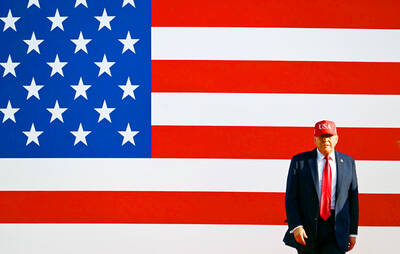Taiwan’s economy is poised to lose steam in the second half of this year, as trade-related uncertainties and currency appreciation weigh on export momentum, Academia Sinica said yesterday, trimming its full-year growth forecast to 2.93 percent from the 3.10 percent it projected in December last year.
The revised projection reflects concerns over the potential impact of US tariffs and a rapidly appreciating New Taiwan dollar, which could erode the price competitiveness of local exporters, the nation’s top academic institution said.
“First-half growth was driven by strong export demand, partly due to front-loaded orders ahead of possible US tariff hikes,” Academia Sinica Institute of Economics research fellow Lin Chang-ching (林常青) said. “That momentum will likely fade in the second half, as the policy outlook turns more uncertain and the NT dollar continues to climb.”

Photo: Ritchie B. Tongo, EPA
The institute’s base scenario assumes a 15 to 20 percent US tariff, an average exchange rate of NT$29 to the US dollar and partial exemptions for semiconductor-related products.
In the worst-case scenario — a 20 percent tariff, no exemptions for semiconductors and NT dollar appreciation higher than NT$28 — growth could slide to just 2.54 percent, Lin said.
A more optimistic outcome, where there is a 10 percent tariff cap and favorable trade treatment, could lift growth to as high as 3.17 percent, he said.
“Taiwan’s semiconductor supply chain is deeply integrated with the US, which offers some room for optimism,” Lin said, adding that the recent outcome of US-Vietnam trade negotiations suggested that the most extreme tariff scenarios might be avoided.
Still, the institute cautioned about sustained pressure on the NT dollar.
Institute of Economics deputy director Susan Yang (楊淑珺) said that market expectations of a weaker US dollar have become a key force behind the local currency’s appreciation.
“If that sentiment persists, it would be difficult to resist further gains in the NT dollar,” Yang said, adding that a return to the NT$27 level — last seen during US President Donald Trump’s first term — is “not out of the question,” depending on the trajectory of US interest rates and US Federal Reserve policy decisions.
Despite the external headwinds, Taiwan’s private investment is projected to grow 5.46 percent this year, bolstered by public infrastructure spending and strong capital expenditure in the semiconductor sector, particularly around artificial intelligence-driven developments.
Inflation is expected to ease to 1.85 percent from the previous estimate of 2.02 percent, helped by the stronger local currency lowering import costs, Academia Sinica said.
Policymakers and industries should reassess their strategies to navigate the new macroeconomic environment as Taiwan adapts to shifting trade dynamics and a potentially long-term appreciation trend in the NT dollar, it said.

When Lika Megreladze was a child, life in her native western Georgian region of Guria revolved around tea. Her mother worked for decades as a scientist at the Soviet Union’s Institute of Tea and Subtropical Crops in the village of Anaseuli, Georgia, perfecting cultivation methods for a Georgian tea industry that supplied the bulk of the vast communist state’s brews. “When I was a child, this was only my mum’s workplace. Only later I realized that it was something big,” she said. Now, the institute lies abandoned. Yellowed papers are strewn around its decaying corridors, and a statue of Soviet founder Vladimir Lenin

UNIFYING OPPOSITION: Numerous companies have registered complaints over the potential levies, bringing together rival automakers in voicing their reservations US President Donald Trump is readying plans for industry-specific tariffs to kick in alongside his country-by-country duties in two weeks, ramping up his push to reshape the US’ standing in the global trading system by penalizing purchases from abroad. Administration officials could release details of Trump’s planned 50 percent duty on copper in the days before they are set to take effect on Friday next week, a person familiar with the matter said. That is the same date Trump’s “reciprocal” levies on products from more than 100 nations are slated to begin. Trump on Tuesday said that he is likely to impose tariffs

HELPING HAND: Approving the sale of H20s could give China the edge it needs to capture market share and become the global standard, a US representative said The US President Donald Trump administration’s decision allowing Nvidia Corp to resume shipments of its H20 artificial intelligence (AI) chips to China risks bolstering Beijing’s military capabilities and expanding its capacity to compete with the US, the head of the US House Select Committee on Strategic Competition Between the United States and the Chinese Communist Party said. “The H20, which is a cost-effective and powerful AI inference chip, far surpasses China’s indigenous capability and would therefore provide a substantial increase to China’s AI development,” committee chairman John Moolenaar, a Michigan Republican, said on Friday in a letter to US Secretary of

Taiwan Semiconductor Manufacturing Co’s (TSMC, 台積電) market value closed above US$1 trillion for the first time in Taipei last week, with a raised sales forecast driven by robust artificial intelligence (AI) demand. TSMC saw its Taiwanese shares climb to a record high on Friday, a near 50 percent rise from an April low. That has made it the first Asian stock worth more than US$1 trillion, since PetroChina Co (中國石油天然氣) briefly reached the milestone in 2007. As investors turned calm after their aggressive buying on Friday, amid optimism over the chipmaker’s business outlook, TSMC lost 0.43 percent to close at NT$1,150